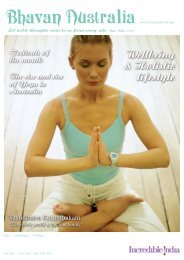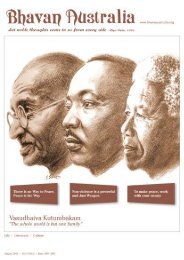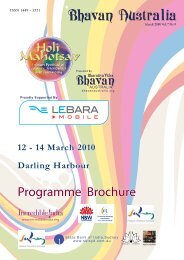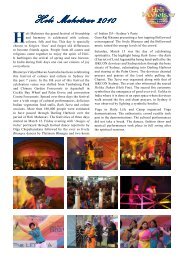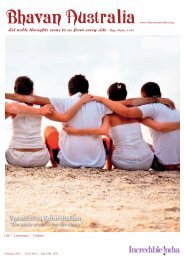'The whole world is but one family' - Bharatiya Vidya Bhavan Australia
'The whole world is but one family' - Bharatiya Vidya Bhavan Australia
'The whole world is but one family' - Bharatiya Vidya Bhavan Australia
Create successful ePaper yourself
Turn your PDF publications into a flip-book with our unique Google optimized e-Paper software.
The <strong>Bharatiya</strong> <strong>Vidya</strong> <strong>Bhavan</strong> has publ<strong>is</strong>hed in eleven<br />
bulky volumes “The H<strong>is</strong>tory and Culture of Indian<br />
People” involving work by 60 H<strong>is</strong>torians and Scholars,<br />
with Dr R.C. Majumdar as the Chief Editor. It took<br />
32 years to complete the eleven volumes. The first<br />
volume deals with “The Vedic Age” and gives an idea<br />
of the evolution of common Indian Culture 5000 years<br />
ago. To quote from the book “We have the Nordic<br />
Aryan speaking group of India, who gave to India its<br />
Aryan speech and by their organ<strong>is</strong>ation, imagination<br />
and adaptability helped to bring about a great Cultural<br />
Synthes<strong>is</strong> leading to the foundation of the Hindu<br />
Civil<strong>is</strong>ation of India. The antiquity of Indian H<strong>is</strong>tory<br />
and Culture as gleaned from Vedic Literature <strong>is</strong> also<br />
not supposed to go beyond the second millennium<br />
before Chr<strong>is</strong>t. But the archaeological d<strong>is</strong>coveries at<br />
Harappa and Mohenjo-Daro and other localities in the<br />
Indus valley have pushed back th<strong>is</strong> limit at a single<br />
stretch to 3000 BC, if not to a still remoter period and<br />
India can now claim the honour of being a pi<strong>one</strong>er<br />
of civil<strong>is</strong>ation along with Sumer, Akkad, Babylon,<br />
Egypt and Assyria.”<br />
The real v<strong>is</strong>ible culture started with the Indus<br />
Civil<strong>is</strong>ation as seen from the excavations of<br />
MohenjoDaro and Harappa. Some of the tanks 5000<br />
years old are still preserved. The culture of writing<br />
was invented by the Indus people. Agriculture had<br />
developed with evidence of specimens of wheat and<br />
barley. Female statues were common representing the<br />
Divine Mother similar to the Indian religious tradition.<br />
“Thus th<strong>is</strong> preh<strong>is</strong>toric culture (3250–2750 BC) mainly<br />
as indigenous growth <strong>is</strong> the linear progenitor of the<br />
Indian Culture of today”.<br />
The Indus culture preceded the Rig Vedic Culture and<br />
there are references in Rig Veda to the non Aryans.<br />
Opinion <strong>is</strong> gaining ground that th<strong>is</strong> Indus culture<br />
and civil<strong>is</strong>ation <strong>is</strong> the earliest in the <strong>world</strong>. Th<strong>is</strong> <strong>is</strong><br />
suggested by scientific research in plant breeding in<br />
wheat. The Indian people had initiated growth of food<br />
crops through agriculture.<br />
In the recent publication “The invasion that never<br />
was” by Michel Danino, the Author has questi<strong>one</strong>d<br />
whether there was any Aryan invasion at all<br />
or immigration. The Author contends that “the ancient<br />
Indian civil<strong>is</strong>ation was in fact the Indus, Saraswathi<br />
civil<strong>is</strong>ation of Aryavartha and it began as a pastoral<br />
civil<strong>is</strong>ation around 6500 or 6000 BC and then entered<br />
a matured phase around 2600 to 1900 BC”. The<br />
occurrence of the word ‘Kr<strong>is</strong>hna has been wrongly<br />
used by the Aryan Race theor<strong>is</strong>ts to conjecturally<br />
advance the theory of, invading Aryans annihilating<br />
indigenous and earlier dark-skinned inhabitants of<br />
India; of the dark skinned people being forefathers of<br />
the so called non Aryan Dravidians who were pushed<br />
south from their earlier northern abodes, of the<br />
so called invading Aryans burning the cities and<br />
villages of indigenous people and of the inhuman<br />
cruelty with which these so called invading Aryans<br />
treated the original inhabitants of India” Ladli Nath<br />
Renu ‘Aryan Cult : No Aryan Race’. Ladli Nath Renu<br />
(2000) was passionate about research into the Vedas<br />
with particular reference to Aryan origin. Based on<br />
intensive research on Rig Veda, Nath came to the<br />
conclusion that there <strong>is</strong> no Aryan race. There <strong>is</strong> only<br />
the Aryan Cult which originated in India with the<br />
sound of OM.<br />
It spread all over the country and abroad. Its<br />
followers were called Aryans.<br />
From 650 BC there <strong>is</strong> political h<strong>is</strong>tory as separate<br />
from cultural h<strong>is</strong>tory. Indian Culture seems to have<br />
got mixed up with political culture, through political<br />
h<strong>is</strong>tory involving the Mauryas, Kushanas, Guptas etc.<br />
in the north and the Pallavas, Cholas, Pandyas and<br />
Cheras in the South. Later h<strong>is</strong>tory tells us about the<br />
Muslim invasions and the Brit<strong>is</strong>h rule. It was only<br />
once in the cultural h<strong>is</strong>tory of the country that the<br />
<strong>whole</strong> of India including the present Baluch<strong>is</strong>tan and<br />
Afghan<strong>is</strong>tan had a common h<strong>is</strong>tory and culture<br />
under the control of a common Government, the<br />
Mauryan empire under Ashoka. In the sixth century,<br />
Buddh<strong>is</strong>m and Jain<strong>is</strong>m added a new dimension to<br />
Indian culture.



